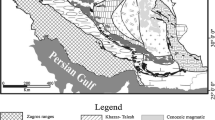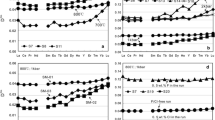Abstract
The mineral ‘fluorite’ is utilized as a probe to investigate the behaviour of the pseudolanthanide yttrium with respect to the lanthanides (rare-earth elements, REE) in fluorine-rich hydrothermal solutions. Hydrothermal vein fluorites are characterized by the close association of Y and REE, but in contrast to igneous and clastic rocks they show variable and nonchondritic Y/Ho ratios of up to 200. This suggests that Y and Ho, although similar in charge and size, may be fractionated in fluorine-rich medium-temperature aqueous fluids. In such solutions Y acts as a pseudolanthanide heavier than Lu. Y/Ho ratios of hydrothermal siderites are slightly below those of chondrites, suggesting that in (bi)carbonate-rich siderite-precipitating solutions Y may act as a Sm-like light pseudolanthanide. This indicates that Y-Ho fractionation is not a sourcerelated phenomenon but depends on fluid composition. Based on these results it is strongly recommended that discussions of normalized REE patterns in general should be extended to normalized Rare-Earth-and-Yttrium (REY) patterns (Y inserted between Dy and Ho), because the slightly variable behaviour of the pseudolanthanide yttrium with respect to the REE may provide additional geochemical information. Available thermodynamic data suggest a negative correlation between Y/Ho and La/Ho during migration of a fluoriteprecipitating hydrothermal solution. Cogenetic fluorites, therefore, should display either similar Y/Ho and similar La/Ho ratios, or a negative correlation between these ratios. This criterion may help to choose samples suitable for Sm-Nd isotopic studies prior to isotope analysis. However, in cogenetic hydrothermal vein fluorites the range of Y/Ho ratios is often almost negligible compared to the range of La/Ho ratios. This may be explained by modification of REE distributions by post-precipitation processes involving (partial) loss of a separate LREE-enriched phase. The presence of variable amounts of such an accessory phase in most fluorite samples is revealed by experiments employing stepwise incomplete fluorite decomposition. Fluorites derived from and deposited near to igneous rocks apparently display chondritic Y/Ho ratios close to those of their igneous source-rocks. However, a positive YSN anomaly is likely to develop as the distance between sites of REY mobilization and deposition increases.
Similar content being viewed by others
References
Ahrens LH (1964) The signification of chemical bond for controlling the geochemical distribution of the elements-I. Phys Chem Earth 5:1–54
Anders E, Grevesse N (1989) Abundances of the elements: metoritic and solar. Geochim Cosmochim Acta 53:197–214
Banfield JF, Eggleton RA (1989) Apatite replacement and rare earth mobilization, fractionation, and fixation during weathering. Clays Clay Miner 37:113–127
Bau M, Dulski P (1992) Y/Ho-Fraktionierung in geochemischen Systemen: erste Ergebnisse. Beih Eur J Min 1:17
Bau M, Möller P (1992) Rare earth element fractionation in metamorphogenic hydrothermal calcite, magnesite and siderite. Mincral Petrol 45:231–256
Bau M, Dulski P, Möller P (1995) Yttrium and holmium in South Pacific seawater: Vertical distribution and possible fractionation mechanisms. Chem Erde (in press)
Borkowski M, Siekierski S (1992) Factors affecting the position of Y and actinides (III) with respect to lanthanides in the NH4SCN-Adogen-564SCN extraction system. Radiochim Acta 56:31–35
Burns PG (1970) Mineralogical applications of crystal field theory. Cambridge Univ Press, Cambridge
Byrne RH, Lee JH (1993) Comparative yttrium and rare-earth element chemistries in seawater. Mar Chem 44:121–130
Chesley JT, Halliday AN, Scrivener RC (1991) Samarium-neodymium direct dating of fluorite mineralization. Science 252:949–951
Chesley JT, Halliday AN, Snee LW, Mezger K, Shepherd TJ, Scrivener RC (1993) Thermochronology of the Cornubian batholith in southwest England: implications for pluton emplacement and protracted hydrothermal mineralization. Geochim Cosmochim Acta 57:1817–1835
Constantopoulos J (1988) Fluid inclusions and rare earth element geochemistry of fluorite from South-Central Idaho. Econ Geol 83:626–636
Cotten J, Le Dez A, Bau M, Caroff M, Maury RC, Dulski P, Fourcase S, Bohn M, Brousse R (1994) Origin of anomalous rare-earth element and yttrium enrichments in subaerially exposed basalts: evidence from French Polynesia. Chem Geol (in press)
Dulski P (1994a) Interferences of oxide, hydroxide and chloride analyte species in determination of rare earth elements in geological samples by inductively coupled plasma-mass spectrometry. Fresenius J Anal Chem 350:194–203
Dulski P (1994b) Distribution of Y and REE in fluorite: An ICP-MS study employing decomposition with AlCl3-solution. Geoanalysis 94, Abstr Vol, Amblcside, England, p. C28
Dunham KC (1990) Geology of the northern Pennine Orefield, Vol. 1. Tyne to Stainmore, (2nd edn.) Economic Memoir British Geological Survey. HMSO, London
Ekambaram V, Brookins DG, Rosenberg PE, Emanuel KM (1986) Rare-earth element geochemistry of fluorite-carbonate deposits in western Montana, U.S.A. Chem Geol 54:319–331
Eppinger RG, Closs LG (1990) Variation of trace elements and rare earth elements in fluorite: a possible tool for exploration. Econ Geol 85:1896–1907
Förster HJ, Thomas R, Tischendorf G (1989) Physicochemical conditions as controlling factors on magmatism and metallogenesis. In: Tischendorf G (ed) Silicic magmatism and metallogenesis of the Erzgebirge. Zentralinstitut Physik Erde, Potsdam, pp 221–243
Franzke HJ, Lüders V (1993) Formation of hydrothermal fluorite vein deposits in the southern Black Forest/Germany. Part I. Structural control. In: Hach-Alt F et al. (eds) Current research in geology applied to ore deposits. University Granada, Granada, pp 719–722
Fyfe WS (1951) Isomorphism and bond type. Am Mineral 36:538–542
Garbe-Schönberg CD (1993) Simultaneous determination of 37 trace elements in 28 international rock standards by ICP-MS. Geostandards Newsletter 17:81–97
Giese U, Möller P, Dulski P (1993) Mobile metals in the Harz Granites. In: Möller P, Lüders V (eds) Formation of hydrothermal vein deposits. Bornträger, Berlin, pp 265–277
Goldschmidt VM (1937) The principles of distribution of chemical elements in minerals and rocks. J Chem Soc 1937:655–672
Govindaraju K (1989) 1989 compilation of working values and sample description for 272 geostandards. Geostandards News-letter (special issue) 13:1–113
Grant PM, Baisden PA, Kinard WF, Torres RA (1988) Enthalpics of formation of the monofluorolanthanide complexes. Inorg Chem 27:1156–1158
Greis O, Haschke JM (1982) Rare earth fluorides. In: Gschneider KA, Eyring L (eds) Handbook on the physics and chemistry of rare earths, vol. 5, North-Holland Publ Comp. Amsterdam pp 387–560
Haas JR, Shock EL, Sassani DC (1993) Predictions of high-temperature stability constants for aqueous complexes of the rare earth elements. GSA Annual Meeting 1993, Boston, Abstr. Vol., p. A437
Halliday AN, Shepherd TJ, Dickin AP, Chesley JT (1990) Sm-Nd evidence for the age and origin of a Mississippi Valley Type ore deposit. Nature 344:54–56
Hein UF (1993) Synmetamorphic Variscan siderite mineralisation of the Rhenish Massif, Central Europe. Mineral Mag 57:451–567
Hinton RW, Upton BGJ (1991) The chemistry of zircon: variations within and between large crystals from syenite and alkali basalt xenoliths. Geochim Cosmochim Acta 55:3287–3302
Høgdahl OT, Bowen BT, Melson S (1968) Neutron activation analysis of lanthanide elements in sea water. Adv Chem Ser 73:308–325
Jochum KP, Seufert HM, Spettel B, Palme H (1986) The solar-system abundances of Nb, Ta, Y, and the relative abundances of refractory lithophile elements in differentiated planetary bodies. Geochim Cosmochim Acta 50:1173–1183
Jones DG, Plant JA, Colman TB, Swainbank IG (1991) New evidence for Visean-Namurian shales as the source of the Pennine mineralisation of England. In: Pagel M, Leroy JL (eds) Source, transport and deposition of metals. Balkema, Rotterdam, pp 309–312
Kämpf H, Kuschka E (1989) Fluorbarytic (Ba, F) depositions. In: Tischendorf G (ed) Silicic magmatism and metallogenesis of the Erzgebirge. Zentralinstitut Physik Erde, Potsdam, pp 154–177
Lottermoser BG (1992) Rare earth elements and hydrothermal ore formation processes. Ore Geol Rev 7:25–41
Lüders V, Franzke HJ (1993) Formation of hydrothermal fluorite deposits in the southern Black Forest (S.W. Germany). Part II. Geochemical features. In: Hach-Alt F et al. (eds) Current research in geology applied to ore deposits. University Granada, Granada, pp 739–742
Lüders V, Möller P, Dulski P (1993) REE fractionation in carbonates and fluorite. In: Möller P, Lüders V (eds) Formation of hydrothermal vein deposits. Bornträger, Berlin, pp 133–150
McLennan SM (1989) Rare earth elements in sedimentary rocks: influence of provenance and sedimentary processes. In: Lipin BR, McKay GA (eds) Geochemistry and mineralogy of rare earth elements (Reviews in Mineralogy vol. 21). Mineralogical Society of America, Washington DC, pp 169–200
Möller P (1991) REE fractionation in hydrothermal fluorite and calcite. In: Pagel M, Leroy JL (eds) Source, transport and deposition of metals. Balkema, Rotterdam, pp 91–94
Möller P, Morteani G (1983) On the geochemcal fractionation of rare earth elements during the formation of Ca-minerals and its application to problems of the genesis of ore deposits. In: Augustithis SS (ed) The significance of trace elements in solving petrogenetic problems and controversies. Theophrastos, Athens, pp 747–791
Morgan JW, Wandless GA (1980) Rare earth elements in some hydrothermal minerals: evidence for crystallographic control. Geochim Cosmochim Acta 44:973–980
Rubin JN, Henry CD, Price JG (1993) The mobility of zirconium and other “immobile” elements during hydrothermal alteration. Chem Geol 110:29–47
Sawkins FJ (1966) Ore genesis in the North Pennine orefield, in the light of fluid inclusion studies. Econ Geol 61:385–401
Schneider HJ, Möller P, Parckh PP, Zimmer E (1977) Fluorine contents in carbonate sequences and rare earths distribution in fluorites of Pb-Zn deposits in East-Alpine Mid-Triassic. Miner Deposita 12:22–36
Schürenberg H (1957) Die Blei-Zinkerzgänge des Südschwarzwaldes. Geol Jahr 29:33–188
Seltmann R, Wetzel HU, Felix M, Schilka W (1987) Brekzien der Altenberger Scholle Gesellschaft of Geologische Wissenschaft. Ann Meeting, Freiberg 1987, Excursion Guide, pp 3–21
Shabani MB, Akagi T, Shimizu H, Masuda A (1990) Determination of trace lanthanides and yttrium in seawater by inductively coupled plasma mass spectrometry after preconcentration with solvent extraction and back-extraction. Anal Chem 62:2709–2714
Shannon RD (1976) Revised effective ionic radii and systematic studies of interatomic distances in halides and chalcogenides. Acta Crystallogr A32:751–767
Shepherd TJ, Darbyshire DPF, Moore GR, Greenwood DA (1982) Rare earth element and isotopic geochemistry of the North Pennine ore deposits. Bull Bur Rech Geol Minieres (2)2:371–377
Siekierski S (1981) The position of yttrium within lanthanides in respect to thermodynamic functions of complex formation. Radiochem Radioanal Lett 48:201–208
Smith FW (1974) Yttrium content of fluorite as a guide to vein intersections in partially developed fluorspar ore bodies. Trans Soc Min Eng AIMS 255:95–96
Subias I, Fanlo I, López Ciriano A, Fernández-Nieto C (1994) Geochemistry and genesis of fluorite mineralization of Spanish Western Pyrenees (Huesca Province). In: Seltmann R et al. (eds) Metallogeny of collisional orogens. Czech Geol Surv, Prague, pp 423–429
Taylor SR, McLennan SM (1985) The continental crust: its composition and evolution. Blackwell, Oxford
Tepper JH, Nelson BK, Bergantz GW, Irving AJ (1993) Petrology of the Chilliwack batholith, North Cascades, Washington: generation of calc-alkaline granitoids by melting of mafic lower crust with variable water fugacitiy. Contrib Mineral Petrol 113:333–351
Thomas R (1979) Untersuchungen von Einschlüsson zur thermodynamischen und physikochemischen Charakteristik lager-stättenbildender Lösungen und Prozesse im magmatischen und postmagmatischen Bereich. PhD dissertation A, Bergakademie Freiberg
Thomas R (1994) Fluid evolution in relation to the emplacement of the Variscan granites in the Erzgebirge region: a review of the melt and fluid inclusion evidence. In: Seltmann R et al. (eds) Metallogeny of collisional orogens. Czech Geol Surv, Prague, pp 224–229
Walker JB, Choppin GR (1967) Thermodynamic parameters of fluoride complexes of the lanthanides. Adv Chem 71:127–140
Wood SA (1990a) The aqueous geochemistry of the rare-earth elements and yttrium. 1. Review of available low-temperature data for inorganic complexes and inorganic REE speciation of natural waters. Chem Geol 82:159–186
Wood SA (1990b) The aqueous geochemistry of the rare-earth elements and yttrium. 2. Theoretical predictions of speciation in hydrothermal solutions to 350°C at saturation water vapor pressure. Chem Geol 88:99–125
Author information
Authors and Affiliations
Rights and permissions
About this article
Cite this article
Bau, M., Dulski, P. Comparative study of yttrium and rare-earth element behaviours in fluorine-rich hydrothermal fluids. Contr. Mineral. and Petrol. 119, 213–223 (1995). https://doi.org/10.1007/BF00307282
Received:
Accepted:
Issue Date:
DOI: https://doi.org/10.1007/BF00307282




